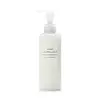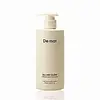What's inside
What's inside
 Key Ingredients
Key Ingredients

 Benefits
Benefits

 Concerns
Concerns

 Ingredients Side-by-side
Ingredients Side-by-side

Water
Skin ConditioningGlycerin
HumectantPEG-7 Glyceryl Cocoate
EmulsifyingHydrogenated Polyisobutene
EmollientCetyl Ethylhexanoate
EmollientPentylene Glycol
Skin ConditioningPropanediol
SolventOlea Europaea Fruit Oil
MaskingIsononyl Isononanoate
EmollientPolyquaternium-51
Skin ConditioningPrunus Armeniaca Juice
MoisturisingPrunus Persica Leaf Extract
EmollientSodium Hyaluronate
HumectantButylene Glycol
HumectantSqualane
EmollientGlyceryl Behenate/Eicosadioate
EmollientPolysorbate 60
EmulsifyingHydroxyethyl Acrylate/Sodium Acryloyldimethyl Taurate Copolymer
Emulsion StabilisingCarbomer
Emulsion StabilisingTocopherol
AntioxidantPotassium Hydroxide
BufferingEthylhexylglycerin
Skin ConditioningPhenoxyethanol
PreservativeCitrus Aurantium Dulcis Peel Oil
MaskingWater, Glycerin, PEG-7 Glyceryl Cocoate, Hydrogenated Polyisobutene, Cetyl Ethylhexanoate, Pentylene Glycol, Propanediol, Olea Europaea Fruit Oil, Isononyl Isononanoate, Polyquaternium-51, Prunus Armeniaca Juice, Prunus Persica Leaf Extract, Sodium Hyaluronate, Butylene Glycol, Squalane, Glyceryl Behenate/Eicosadioate, Polysorbate 60, Hydroxyethyl Acrylate/Sodium Acryloyldimethyl Taurate Copolymer, Carbomer, Tocopherol, Potassium Hydroxide, Ethylhexylglycerin, Phenoxyethanol, Citrus Aurantium Dulcis Peel Oil
Water
Skin ConditioningHelianthus Annuus Seed Oil
EmollientButylene Glycol
HumectantSimmondsia Chinensis Seed Oil
EmollientDipropylene Glycol
HumectantGlycerin
Humectant1,2-Hexanediol
Skin ConditioningGlyceryl Stearate
EmollientCetearyl Stearate
Skin ConditioningCetearyl Olivate
Sorbitan Olivate
EmulsifyingCeramide NP
Skin ConditioningCentella Asiatica Extract
CleansingPropolis Extract
Skin ConditioningAsiaticoside
AntioxidantMadecassoside
AntioxidantMadecassic Acid
Skin ConditioningAsiatic Acid
Skin ConditioningAllantoin
Skin ConditioningPanthenol
Skin ConditioningPropanediol
SolventArachidyl Alcohol
EmollientDecyl Glucoside
CleansingBehenyl Alcohol
EmollientArachidyl Glucoside
EmulsifyingCarbomer
Emulsion StabilisingCaprylyl Glycol
EmollientArginine
MaskingEthylhexylglycerin
Skin ConditioningAlcohol Denat.
AntimicrobialSodium Carbonate
BufferingCitric Acid
BufferingDipotassium Glycyrrhizate
HumectantWater, Helianthus Annuus Seed Oil, Butylene Glycol, Simmondsia Chinensis Seed Oil, Dipropylene Glycol, Glycerin, 1,2-Hexanediol, Glyceryl Stearate, Cetearyl Stearate, Cetearyl Olivate, Sorbitan Olivate, Ceramide NP, Centella Asiatica Extract, Propolis Extract, Asiaticoside, Madecassoside, Madecassic Acid, Asiatic Acid, Allantoin, Panthenol, Propanediol, Arachidyl Alcohol, Decyl Glucoside, Behenyl Alcohol, Arachidyl Glucoside, Carbomer, Caprylyl Glycol, Arginine, Ethylhexylglycerin, Alcohol Denat., Sodium Carbonate, Citric Acid, Dipotassium Glycyrrhizate
 Reviews
Reviews

Ingredients Explained
These ingredients are found in both products.
Ingredients higher up in an ingredient list are typically present in a larger amount.
Butylene Glycol (or BG) is used within cosmetic products for a few different reasons:
Overall, Butylene Glycol is a safe and well-rounded ingredient that works well with other ingredients.
Though this ingredient works well with most skin types, some people with sensitive skin may experience a reaction such as allergic rashes, closed comedones, or itchiness.
Learn more about Butylene GlycolCarbomer is a polymer of acrylic acid. Its main role is to create a gel consistency.
A high amount of carbomer can cause pilling or balling up of products. Don't worry, most products contain 1% or less of carbomer.
Ethylhexylglycerin (we can't pronounce this either) is commonly used as a preservative and skin softener. It is derived from glyceryl.
You might see Ethylhexylglycerin often paired with other preservatives such as phenoxyethanol. Ethylhexylglycerin has been found to increase the effectiveness of these other preservatives.
Glycerin is already naturally found in your skin. It helps moisturize and protect your skin.
A study from 2016 found glycerin to be more effective as a humectant than AHAs and hyaluronic acid.
As a humectant, it helps the skin stay hydrated by pulling moisture to your skin. The low molecular weight of glycerin allows it to pull moisture into the deeper layers of your skin.
Hydrated skin improves your skin barrier; Your skin barrier helps protect against irritants and bacteria.
Glycerin has also been found to have antimicrobial and antiviral properties. Due to these properties, glycerin is often used in wound and burn treatments.
In cosmetics, glycerin is usually derived from plants such as soybean or palm. However, it can also be sourced from animals, such as tallow or animal fat.
This ingredient is organic, colorless, odorless, and non-toxic.
Glycerin is the name for this ingredient in American English. British English uses Glycerol/Glycerine.
Learn more about GlycerinPropanediol is an all-star ingredient. It softens, hydrates, and smooths the skin.
It’s often used to:
Propanediol is not likely to cause sensitivity and considered safe to use. It is derived from corn or petroleum with a clear color and no scent.
Learn more about PropanediolWater. It's the most common cosmetic ingredient of all. You'll usually see it at the top of ingredient lists, meaning that it makes up the largest part of the product.
So why is it so popular? Water most often acts as a solvent - this means that it helps dissolve other ingredients into the formulation.
You'll also recognize water as that liquid we all need to stay alive. If you see this, drink a glass of water. Stay hydrated!
Learn more about Water